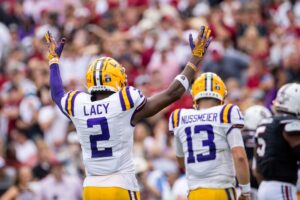Games between SEC schools and FCS teams usually go more-or-less unnoticed. We only ever look at these games for the gaudy stats and highlight-reel plays that the more talented team inevitably produces. This is a problem in its own right–why do we reward playing lesser competition with accolades on TV and sports talk shows–but that is an issue for a different time. Today’s issue is that, by otherwise ignoring these games, we let coaches get away with terrible decision-making.
At the end of Texas A&M’s game against Nicholls (whose sports teams are commonly referred to as “Nicholls State”), the Aggies held a seven-point lead with under two minutes remaining. Nicholls had existed its timeouts, so Texas A&M was three knees away from ending the game. Aggies coach Kevin Sumlin, not content with a one-score win over an FCS opponent, tried to punch in a superfluous touchdown to make the final score more palatable.
The Aggies failed. After throwing an incompletion on 3rd and goal with 18 seconds left, Texas A&M kicked a field goal to take a ten-point lead. Nicholls did not pull off any miracles in the final few seconds, so the game ended as a 24-14 Aggies victory. Before getting into why Sumlin’s decision to score is baffling, let’s remember why we expect coaches to take knees.
Always take knees
First, a history lesson. The kneel-down began after the 1978 “Miracle at the Meadowlands” game between the New York Giants and Philadelphia Eagles. The Giants led that game late, and they had the ball with the ability to control the clock until the end. Back then, teams ran fullback dives or quarterback sneaks as the “safe” play to kill the clock. Well, in this “Miracle” game, the Giants fumbled on their “safe” play, and the Eagles recovered. Philadelphia then went on to score and win the game. The immediate aftermath of this was the development of the “victory formation,” now nearly-universally used by teams to kill the clock.
Of course, some coaches still haven’t learned this lesson. Mike Leach eschewed kneeling down in the 2013 New Mexico Bowl, and it cost his team the game (start watching at the 1:14:00 mark for the hilarious mismanagement). We still remember Leach’s mistake, and Sumlin was one unfortunate play away form joining him.
Additionally, running plays risks players getting hurt. The odds of an injury on any given play are low, but still much higher than when running a kneel-down. Texas A&M had this game won. It was not pretty, but it was a win. Losing a lineman (or a quarterback) to a freak injury on an unnecessary play is just not a risk worth taking.
Additionally, Texas A&M only led by one score. A strip, and interception, or even a blocked field goal all could have led to a game-changing reversal. Why did Kevin Sumlin repeat a mistake that the football world learned not to make almost four decades ago?
Why did he do it?
The reasoning for this choice is pretty obvious. Texas A&M was coming off an embarrassing loss to UCLA. The Aggies were the butt of many national jokes all week (though Baylor spared them a lot of misery), and Sumlin needed to show that his team is still a contender. No one watches SEC vs FCS games, especially when they air on ESPNU. A 14-point win looks a lot more than a seven-point win on a box score. Following up an embarrassing loss with a seven-point win over an FCS team just looks bad. A 14-point win? Not as bad. For a coach presumed to be on a very hot seat, that matters.
Luckily for Sumlin and Texas A&M, nothing went horrifically wrong. The CFB media ignored the game, so no one has even mocked Texas A&M for failing to score the touchdown it was aiming for. No one has even called Sumlin out for not taking knees. And that’s a problem.
Texas A&M had the game won. Sumlin risked blowing that by not taking knees, yes. But he also unnecessarily put players on both teams at injury risk by running four pointless plays–followed by a kickoff, the most dangerous play in football. Football is a dangerous enough game as it is. We love it, but we also acknowledge that. There should be no excuse for not taking knees once the game is in hand. It’s bad for the game, to start–that’s a lesson we learned in 1978. But it also puts these student-athletes in a dangerous situation on the field longer than necessary. In this day and age, there’s no excuse for that. And it’s high time the college football world call Kevin Sumlin out for doing it–as we should to anyone who follows in his footsteps.
Main Photo







